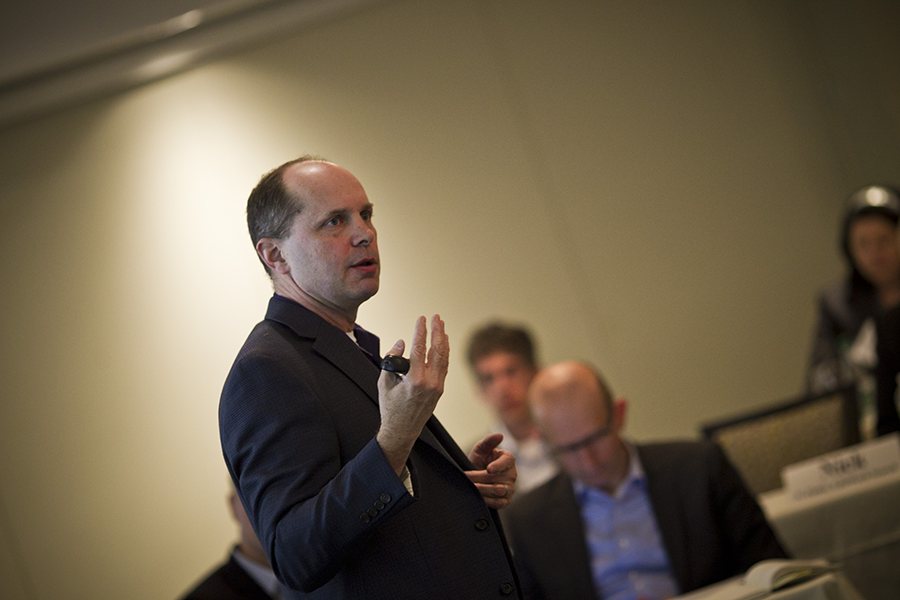
Dr Caplice serves as the Executive Director of the Massachusetts Institute of Technology’s Center for Transportation & Logistics (CTL) where he is responsible for the planning and management of the research, education, and corporate outreach programs for the center. He created and currently serves as Director of the MITx MicroMaster’s Program in Supply Chain Management – the very first MicroMasters credential ever offered. In the first four years more than 250,000 students from 196 different countries have participated in these online courses and more than 20,000 Verified Certificates have been awarded.
Dr. Caplice is currently researching ways to increase the level of attendance, participation, and completion of MOOCs by designing, developing, and implementing a range of different tools and techniques to engage online learners.
Why do you think it’s so hard to keep online learners engaged?
This is the double-edged sword of MOOCs. On one side, the exceptionally low cost (free!) attracts many learners who would otherwise not have registered. This is one of the most exciting ideas behind edX – that anyone from anywhere with Internet access can engage in classes from premiere institutions for free! The other side of this, however, is that whenever there is a low cost to join something, there is not a strong incentive to stay. The trick is to get the learner to commit something to the course – becoming verified, for example. Once a student has “skin in the game” the retention and engagement statistics totally flip.
This is why Dr. Eva Ponce, Executive Director of the MicroMasters in Supply Chain Management, and I have spent (and continue to spend) tremendous effort and energy in developing incentives for learners to become verified. We have found that verified learners have much higher engagement rates, higher retention rates, and higher scores than audit (free) learners.
What interventions or incentives do you think will be most effective for online learners?
This is what the research team is trying to figure out! Two of the SCx course leads, Dr. Sergio Caballero and Dr. Inma Borrella, have conducted a number of different experiments in several of our SCx courses. They are part of the core research team here at CTL trying to engage the online learners. There are really two problems. First, getting learners to become verified. It is far and away the most effective way to keep learners engaged throughout the course. Second, is reducing the drop out rate during the duration of our 13 week courses. Sergio and Inma, along with Connor Makowski, our Digital Learning Lead, have tried different intervention strategies at specific time points in the curriculum. Across the 20 plus courses we have run, we have found that the highest point of “drop off” is in the first week – where the verified learner – even though they paid their fee – does not do any work at all during the course. The second biggest drop-off point is after the mid-term – the first big challenge they face. We are continuing to develop and test different ways of encouraging learners to push forward – even if they perform poorly on a graded assignment or exam. As I mentioned, this is on-going work.
Are there ways to identify types of learners who may be more receptive to interventions?
Dr. Borrella and Caballero have also started developing predictive models for potential drop-outs. The thought is to identify those “learners-at-risk” as early as possible in order to be able to formulate an intervention plan as soon as possible. So far, they have tried both Logistic Regression models and Random Forests to try to classify potential drop-outs. The initial results are promising. The accuracy (number of learners correctly predicted over total learners) for the models ranged from 90% to 96%. This is a very good start!
What do you consider the biggest challenge facing educators today?
Staying relevant. I continually struggle with how to teach different concepts and principles to students. Creating these online courses has significantly changed the way I teach. First, it made me really re-visit topics and lectures I have been giving for over a decade with a new set of eyes. There is nothing like knowing 20,000 people will be watching your presentation to make you spend a little more time polishing it! Second, though, it introduced a whole new set of tools to my teaching toolbox that I can use in my face-to-face courses that I teach here on campus. It has raised the question, which teaching mode (videos, interactive games, anonymous polling, class discussion, small group discussion, class debate, etc.) should I use for different topics? This has, I hope, improved the quality of the learning in my classrooms – both physical and virtual.
What is your favorite thing about working at MIT?
This is a softball question. The people are far and away the best aspect of being at MIT. The students are top notch and always engaged, but I am referring more to my colleagues. Especially at the center where I work, the Center for Transportation & Logistics. Professor Yossi Sheffi, the Director, has created an amazing entrepreneurial environment at CTL for our researchers and teaching faculty. This has enabled all of the researchers to focus on their areas of passion and create truly amazing results. The MicroMasters team, run by Dr. Eva Ponce, has, on their own, created new ways of running courses and conducting assessments. Dr. Bruce Arntzen not only leads the 10 month in-residence masters program, he coordinates and shapes the 5 other graduate programs run across our Supply Chain and Logistics Excellence (SCALE) network. Dr. Josue Velazquez has created from scratch the blended SCM masters program and led its very first cohort in June. All of these researchers are passionate about the students and the programs – and their dedication shows. Working with excellent performers breeds excellence from others. This is why I love working at MIT.